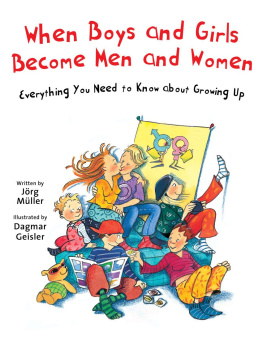Why Cant My Son Read?

Acknowledgements
We would like to acknowledge all the boys who struggle with dyslexia and any reading difficulty. The faces of all the boys with whom we have worked streamed before our eyes as each page was written. The pain and courage of each parent whom we have had the privilege to support is etched on our hearts. This book is written for them and all the boys whose lives we cant touch. We hope our words in some way ease their pain and that of their parents.
Many thanks and appreciation is also given to our children. Zac Hurst, Michelle Hurst, Liz Ruth, and Brent Ruth have provided constant love and encouragement to us in this venture. Our oldest son, Dr. Eric Hurst, continues to provide unique support as our mentor. To have a child as a mentor is a unique and wonderful experience. Our first grandchild, Aiden Zachary Hurst, was born on February 16, 2014, and will face the challenge of learning to read in a hostile world. May God and all his angels protect Aiden on his journey.
Copyright 2015, Prufrock Press Inc.
Edited by Bethany Johnsen
Cover and layout design by Raquel Trevino
ISBN-13: 978-1-61821-240-5
No part of this book may be reproduced, translated, stored in a retrieval system, or transmitted, in any form or by any means, electronic, mechanical, photocopying, microfilming, recording, or otherwise, without written permission from the publisher.
At the time of this books publication, all facts and figures cited are the most current available. All telephone numbers, addresses, and websites URLs are accurate and active. All publications, organizations, websites, and other resources exist as described in the book, and all have been verified. The author and Prufrock Press Inc. make no warranty or guarantee concerning the information and materials given out by organizations or content found at websites, and we are not responsible for any changes that occur after this books publication. If you find an error, please contact Prufrock Press Inc.

| Prufrock Press Inc.
P.O. Box 8813
Waco, TX 76714-8813
Phone: (800) 998-2208
Fax: (800) 240-0333
http://www.prufrock.com |

Table of Contents
Chapter 1

A Recipe for Failure
Something is rotten in the state of boys education, and I cant help but think that the pattern I have seen in my classroom may have something to do with a collective failure to adequately educate boys. These words were written by Jessica Lahey (2013), but anyone who looks at the grim statistics on boys in school might be tempted to agree. Boys get expelled from preschool at nearly five times the rate of girlsand thats only the beginning. Compared to girls, boys are twice as likely to be held back a grade, four times more likely to be disagnosed with learning disabilities and attention problems, account for 70% of Ds and Fs, are 30% more likely to drop out of school, and make up only 43% of college students (Gurian & Stevens, 2004; Reichert & Hawley, 2010).
Educators share a duty to create an America with equitable learning opportunities for every student in the classroom. The focus on providing appropriate opportunities for boys is a relatively recent issue, but one that school systems are addressing with increasing urgency. A study on gender disparities in elementary school performance examined both the objective and subjective aspects of boys deteriorating academic performance (Cornwell, Mustard, & Van Parys, 2013). Surprisingly, it showed that the grades awarded by teachers are not aligned with test scores. Girls in every racial category outperform boys on reading tests, while boys score at least as well on math and science tests as girls. However, boys in all racial categories across all subject areas are not represented in grade distributions where their test scores would predict.
There are some exceptions to this puzzling phenomenon. Boys who shared the girls positive attitude toward learning received the same grade. The well-socialized boys received a higher grade for good behavior. In short, boys who match girls on both test scores and behavior get better grades than girls, while boys who match girls on test scores but have bad behavior are graded more harshly. This means that the issue of what to do with underperforming boys just became much more complicated (Christakis, 2013).
Identifying the Issues
The U.S. Department of Education reading tests for the last 30 years show boys scoring worse than girls in every age group, every year. The following are a few possible explanations for why boys are having reading trouble:
Biologically, boys are slower to develop than girls and often struggle with reading and writing skills early on.
The action-oriented, competitive learning style of many boys works against them learning to read and write.
Many books boys are asked to read dont appeal to them. They arent motivated to read.
Our society teaches boys to suppress feelings. Many boys dont feel comfortable exploring the emotions found in fiction.
Boys dont have enough positive male role models for literacy. Because the majority of adults involved in kids reading are women, boys might not see reading as a masculine activity.
The frightening fact is that as boys get older, they increasingly describe themselves as nonreaders. This perception of self as a nonreader could manifest itself as avoidance of reading because of below-grade-level skills, feelings of defeat that turn off the desire to read, or sidestepping situations that have the potential to expose him to the shame related to poor oral reading skills. Few boys have this attitude early in their schooling, but nearly 50% describe themselves as non-readers by the time they enter secondary school (Beers, 1996).
The downward spiral continues as boys in middle and high school report fewer social supports, less self-efficacy, and lower intrinsic motivation than girls of the same age. In particular, boys admit to putting significantly less effort into their schoolwork and preparing for class than girls describe (Madden & Allen, 2006).
Where does this discrepancy begin? Answering this question requires that we take a long, hard look at what is happening in early childhood education. Boys start off their schooling on the wrong foot when they enter kindergarten classrooms that are mismatched with their phase of development and intolerant of their unique style of play.
Inappropriate Academic Expectations
Ask a kindergarten teacher the following question: How long can the average 5-year-old boy sit still, be quiet, and pay attentioncompared with the average 5-year-old girl? Most teachers will tell you that the boy cannot sit still, be quiet, and pay attention for nearly as long as the girl. The boy starts squirming, fidgeting, and getting restless. Behavior and abilities that are developmentally appropriate for a 5-year-old girl may not be developmentally appropriate for a 5-year-old boy.
The most profound difference between girls and boys is not in any brain structure per se, but rather in the developmental sequence of the various brain regions. The fact that different brain regions develop in a different order, and at a different rate, for boys versus girls is a key insight from the past 5 years of neuroscientific research on brain development. The worlds largest study of brain development in children (National Institutes of Health [NIH], 2007) has demonstrated dramatic differences in the trajectories of brain development between genders.
Next page











